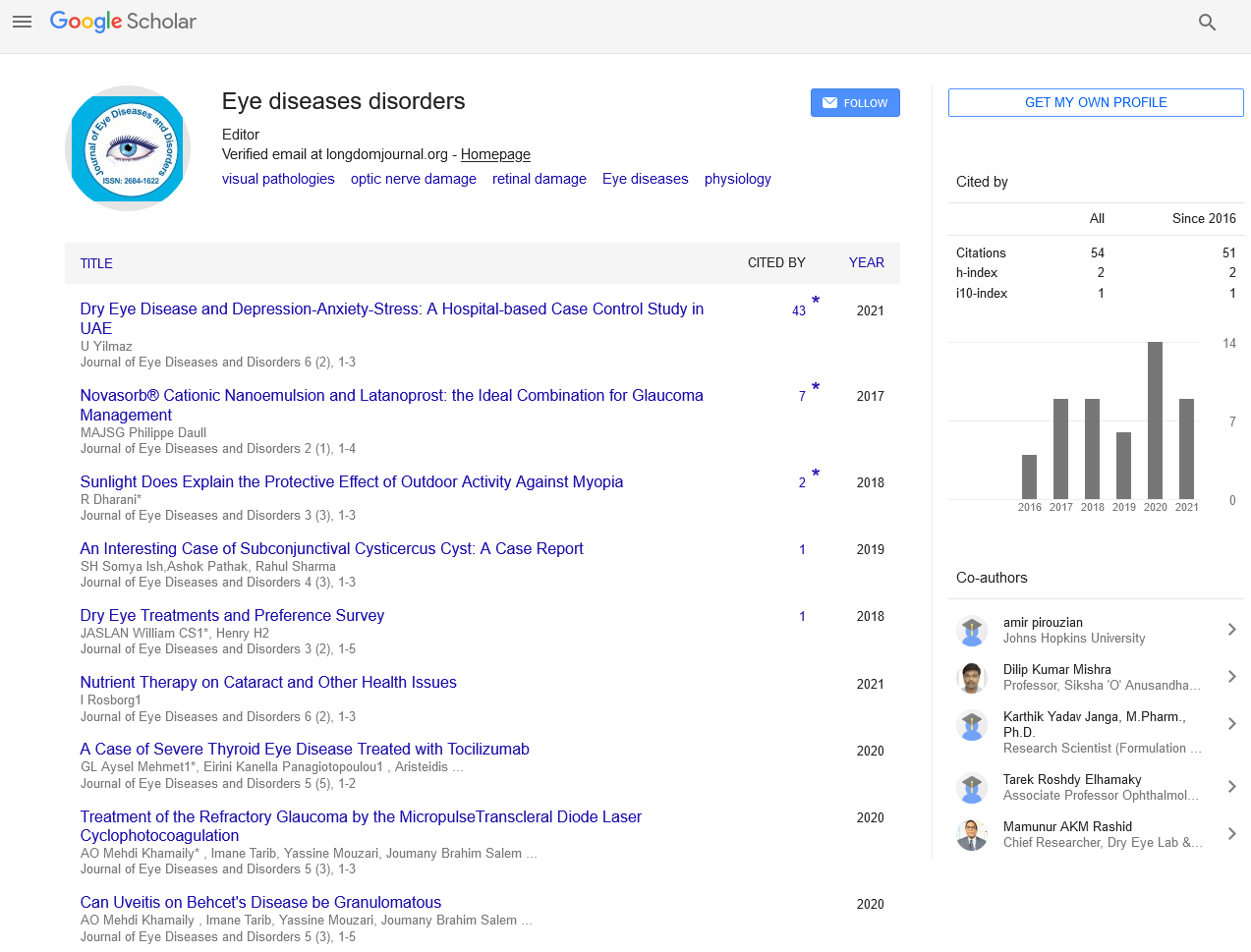Indexed In
- RefSeek
- Hamdard University
- EBSCO A-Z
- Geneva Foundation for Medical Education and Research
- Euro Pub
- Google Scholar
Useful Links
Share This Page
Journal Flyer
Open Access Journals
- Agri and Aquaculture
- Biochemistry
- Bioinformatics & Systems Biology
- Business & Management
- Chemistry
- Clinical Sciences
- Engineering
- Food & Nutrition
- General Science
- Genetics & Molecular Biology
- Immunology & Microbiology
- Medical Sciences
- Neuroscience & Psychology
- Nursing & Health Care
- Pharmaceutical Sciences
Editorial - (2020) Volume 5, Issue 6
Prevalent Etiology of Eye Redness and Discharge: Conjuntivis
Rithuraj Videkar*Received: 24-Nov-2020 Published: 16-Dec-2020, DOI: 10.35248/2684-1622.5.6.e112
Description
Pink eye (conjunctivitis) is an aggravation or disease of the straightforward layer (conjunctiva) that lines your eyelid and covers the white piece of your eyeball. At the point when little veins in the conjunctiva become aroused, they're more noticeable. This is the thing that makes the whites of your eyes seem rosy or pink. In spite of the fact that pink eye can be disturbing, it infrequently influences your vision. Medicines can help facilitate the uneasiness of pink eye. Since pink eye can be infectious, early finding and treatment can help limit its spread.
Most instances of pink eye are ordinarily brought about by adenovirus yet can likewise be brought about by herpes simplex infection, varicella-zoster infection, and different other infections, including the infection that causes Covid sickness 2019 (COVID-19) [1]. Both viral and bacterial conjunctivitis can happen alongside colds or manifestations of a respiratory disease, for example, a sensitive throat. Wearing contact focal points that aren't cleaned appropriately or aren't your own can cause bacterial conjunctivitis. The two kinds are extremely infectious. They are spread through immediate or roundabout contact with the fluid that channels from the eye of somebody who's contaminated. One or the two eyes might be influenced.
Hypersensitive conjunctivitis influences the two eyes and is a reaction to a sensitivity causing substance, for example, dust. Because of allergens, your body creates a neutralizer called Immunoglobulin E (IgE). This neutralizer triggers extraordinary cells called pole cells in the mucous coating of your eyes and aviation routes to deliver provocative substances, including histamines. Your body's arrival of histamine can deliver various hypersensitivity signs and manifestations, including red or pink eyes [2].
In the event that you have hypersensitive conjunctivitis, you may encounter extreme tingling, tearing and aggravation of the eyesjust as wheezing and watery nasal release [3]. Most unfavorably susceptible conjunctivitis can be controlled with hypersensitivity eyedrops.
Aggravation from a compound sprinkle or unfamiliar item in your eye is additionally connected with conjunctivitis [4]. Some of the time flushing and cleaning the eye to free it of the compound or article causes redness and bothering. Signs and indications, which may incorporate watery eyes and a mucous release, normally clear up all alone inside about a day.
In the event that underlying flushing doesn't resolve the manifestations, or if the compound is a harsh one, for example, lye, you should be seen by your primary care physician or eye expert as quickly as time permits. A substance sprinkle into the eye can cause lasting eye harm. Constant side effects could likewise show that you actually have the unfamiliar body in your eye-or conceivably a scratch over the cornea or the covering of the eyeball (sclera).
Babies' eyes are vulnerable to microbes regularly introduce in the mother's introduction to the world trench. These microscopic organisms cause no side effects in the mother. In uncommon cases, these microscopic organisms can make babies build up a genuine type of conjunctivitis known as ophthalmia neonatorum, which needs treatment immediately to protect sight [5]. That is the reason soon after birth; an anti-toxin treatment is applied to each infant's eyes. The balm forestalls eye contamination.
REFERENCES
- Roth DB, Sears JE, Lewis H. Removal of retained subfoveal perfluoro-n-octane liquid. Am J Ophthalmol. 2004; 138: 287-289.
- Garcia-Arumi J, Castillo P, Lopez M. Removal of retained subretinal perfluorocarbon liquid. Br J Ophthalmol. 2008; 92: 1693-1694.
- Lesnoni G, Rossi T, Gelso A. Subfoveal liquid perfluorocarbon. Retina. 2004; 24: 172-176.
- Jae MK, Se JW, Kyu HP, Hum C. Surgical removal of retained subfoveal perfluorocarbon liquid through a therapeutic macular hole with intravitreal pfcl injection and gas tamponade. Korean J Ophthalmol. 2013; 27(5): 392-395.
- Le Tien V, Pierre-Kahn V, Azan F. Displacement of retained subfoveal perfluorocarbon liquid after vitreoretinal surgery. Arch Ophthalmol. 2008; 126: 98-101.
Citation: Videkar R (2020) Prevalent Etiology of Eye Redness and Discharge: Conjuntivis. J Eye Dis Disord. 5:e112
Copyright: © 2020 Videkar R. This is an open-access article distributed under the terms of the Creative Commons Attribution License, which permits unrestricted use, distribution, and reproduction in any medium, provided the original author and source are credited.

